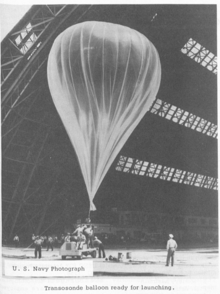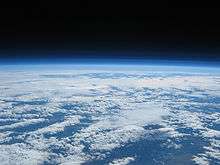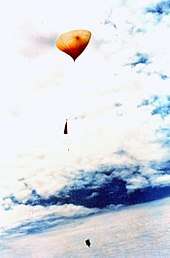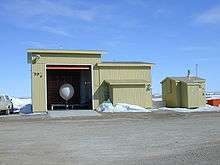Weather balloon



A weather or sounding balloon is a balloon (specifically a type of high-altitude balloon) that carries instruments aloft to send back information on atmospheric pressure, temperature, humidity and wind speed by means of a small, expendable measuring device called a radiosonde. To obtain wind data, they can be tracked by radar, radio direction finding, or navigation systems (such as the satellite-based Global Positioning System, GPS). Balloons meant to stay at a constant altitude for long periods of time are known as transosondes. Weather balloons that do not carry an instrument pack are used to determine upper-level winds and the height of cloud layers. For such balloons, a theodolite or total station is used to track the balloon's azimuth and elevation, which are then converted to estimated wind speed and direction and/or cloud height, as applicable.
History
One of the first people to use weather balloons was Léon Teisserenc de Bort, the French meteorologist. Starting in 1896 he launched hundreds of weather balloons from his observatory in Trappes, France. These experiments led to his discovery of the tropopause and stratosphere.[1] Transosondes, weather balloons with instrumentation meant to stay at a constant altitude for long periods of time to help diagnose radioactive debris from atomic fallout, were experimented with in 1958.[2]
Materials and equipment
The balloon itself produces the lift, and is usually made of a highly flexible latex material, though Chloroprene may also be used. The unit that performs the actual measurements and radio transmissions hangs at the lower end of the string, and is called a radiosonde. Specialized radiosondes are used for measuring particular parameters, such as determining the ozone concentration.
The balloon is usually filled with hydrogen due to lower cost, though helium can also be used. The ascent rate can be controlled by the amount of gas with which the balloon is filled. Weather balloons may reach altitudes of 40 km (25 miles) or more, limited by diminishing pressures causing the balloon to expand to such a degree (typically by a 100:1 factor) that it disintegrates. In this instance the instrument package is usually lost.[3] Above that altitude sounding rockets are used, and for even higher altitudes satellites are used.
Launch time, location, and uses

Weather balloons are launched around the world for observations used to diagnose current conditions as well as by human forecasters and computer models for weather forecasting. About 800[4] locations around the globe do routine releases, twice daily, usually at 0000 UTC and 1200 UTC. Some facilities will also do occasional supplementary "special" releases when meteorologists determine there is a need for additional data between the 12-hour routine launches in which time much can change in the atmosphere. Military and civilian government meteorological agencies such as the National Weather Service in the US typically launch balloons, and by international agreements almost all the data are shared with all nations.
Specialized uses also exist, such as for aviation interests, pollution monitoring, photography or videography and research. Examples include pilot balloons (Pibal). Field research programs often use mobile launchers from land vehicles as well as ships and aircraft (usually dropsondes in this case). In recent years weather balloons have also been used for scattering human ashes at high-altitude by companies such as Stardust Ashes, founded by Chester Mojay-Sinclare.[5]
The Weather balloon was also used to create the fictional entity 'Rover' during production of the 1960s TV series 'The Prisoner' in Portmeirion, Gwynedd, North Wales, UK in September 1966. This was retained in further scenes shot at MGM Borehamwood UK during 1966-67.[6]
See also
References
- ↑

- ↑ Staff (February 1958). "Chief Special Projects Section: Dr. Lester Machta" (PDF). United States Weather Bureau: 39–41. Retrieved 21 April 2012.
- ↑ Radiosonde
- ↑ NWS factsheet Archived 2016-02-20 at the Wayback Machine.
- ↑ "Out of this world! Space fan gives late grandmother the ultimate send-off by scattering her ashes in SPACE". The Daily Mail.
- ↑ Paul-Davies, Steven (2002). The Prisoner Handbook. London: Pan Books. ISBN 978-0-230-53028-7.
External links
| Wikimedia Commons has media related to Weather balloon. |
- Atmospheric Soundings for Canada and the United States – University of Wyoming
- Balloon Lift With Lighter Than Air Gases – University of Hawaii
- Examples of Launches of Instrumented Balloons in Storms – NSSL
- Federal Meteorological Handbook No. 3 – Rawinsonde and Pibal Observations
- Kites and Balloons – NOAA Photo Library
- NASA Balloon Program Office – Wallops Flight Facility, Virginia
- National Science Digital Library: Weather Balloons – Lesson plan for middle school
- Pilot Balloon Observation Theodolites – Martin Brenner, CSULB
- StratoCat – Historical recompilation project on the use of stratospheric balloons in the scientific research, the military field and the aerospace activity
- WMO spreadsheet of all Upper Air stations around the world (revised location September 2008)